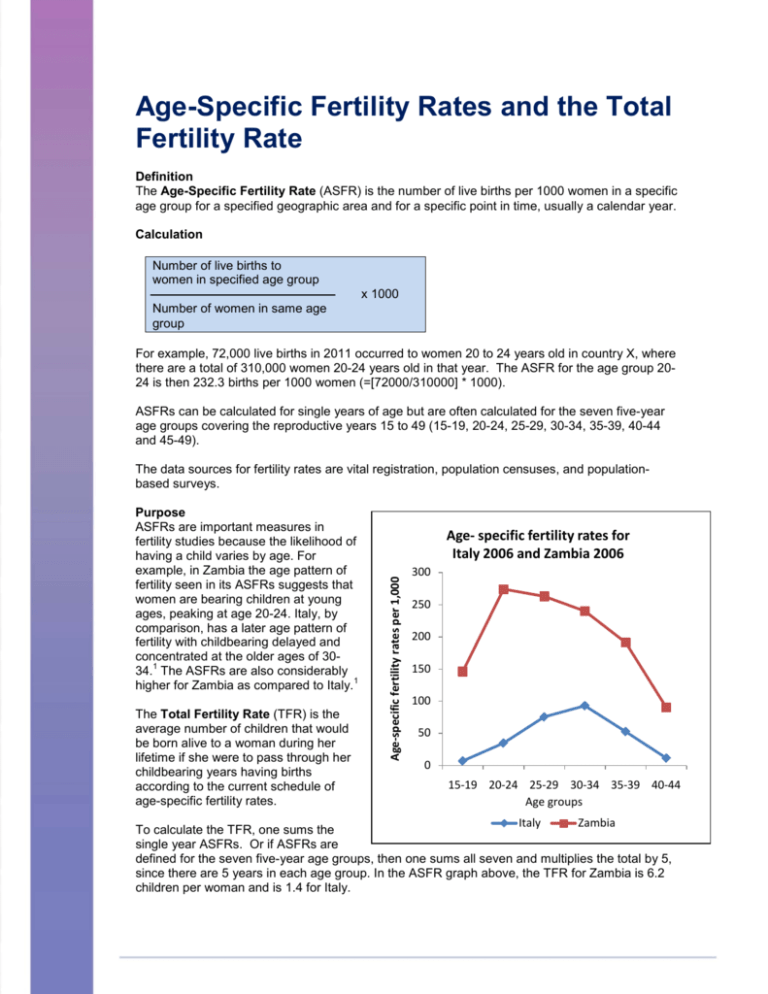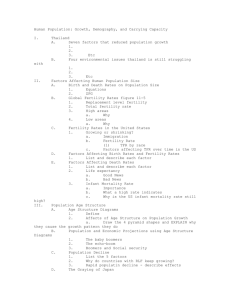Age-Specific Fertility Rates and the Total Fertility Rate
advertisement

Age-Specific Fertility Rates and the Total Fertility Rate Definition The Age-Specific Fertility Rate (ASFR) is the number of live births per 1000 women in a specific age group for a specified geographic area and for a specific point in time, usually a calendar year. Calculation Number of live births to women in specified age group x 1000 Number of women in same age group For example, 72,000 live births in 2011 occurred to women 20 to 24 years old in country X, where there are a total of 310,000 women 20-24 years old in that year. The ASFR for the age group 2024 is then 232.3 births per 1000 women (=[72000/310000] * 1000). ASFRs can be calculated for single years of age but are often calculated for the seven five-year age groups covering the reproductive years 15 to 49 (15-19, 20-24, 25-29, 30-34, 35-39, 40-44 and 45-49). The data sources for fertility rates are vital registration, population censuses, and populationbased surveys. The Total Fertility Rate (TFR) is the average number of children that would be born alive to a woman during her lifetime if she were to pass through her childbearing years having births according to the current schedule of age-specific fertility rates. Age- specific fertility rates for Italy 2006 and Zambia 2006 Age-specific fertility rates per 1,000 Purpose ASFRs are important measures in fertility studies because the likelihood of having a child varies by age. For example, in Zambia the age pattern of fertility seen in its ASFRs suggests that women are bearing children at young ages, peaking at age 20-24. Italy, by comparison, has a later age pattern of fertility with childbearing delayed and concentrated at the older ages of 301 34. The ASFRs are also considerably 1 higher for Zambia as compared to Italy. 300 250 200 150 100 50 0 15-19 20-24 25-29 30-34 35-39 40-44 Age groups Italy Zambia To calculate the TFR, one sums the single year ASFRs. Or if ASFRs are defined for the seven five-year age groups, then one sums all seven and multiplies the total by 5, since there are 5 years in each age group. In the ASFR graph above, the TFR for Zambia is 6.2 children per woman and is 1.4 for Italy. The graph on the left shows TFRs in 1990 and 2010 for the world 2 and its major regions. Currently. the average woman in the world would bear 2.5 children in her lifetime at current rates. In subSaharan Africa the TFR for 2010 is highest at 5.1 births. TFRs tend to be higher in developing countries than in more industrialized countries. A concept that is widely associated with TFR is replacement level fertility. A TFR of 2.1 is replacement fertility since an average of two births is needed to “replace” a mother and father but only if the births survive to reproductive age. An extra 0.1 birth is added to offset the effects of premature death. Higher fertility in developing countries occurs for a number of reasons all of which work synergistically and to varying degrees depending on the country, religion, culture, and social norms. These reasons include but are not limited to the following: • lack of availability to affordable family planning, • religious restrictions on the use of family planning, • a desire for more children as labor supply and for security in old age, • a desire for one or more children of a particular gender • female literacy, and • female participation in the workforce Sources 1 United Nations, Department of Economic and Social Affairs, Population Division. World Fertility Data 2008. United Nations, Department of Economic and Social Affairs, Population Division. World Population Prospects: The 2010 Revision. 2










